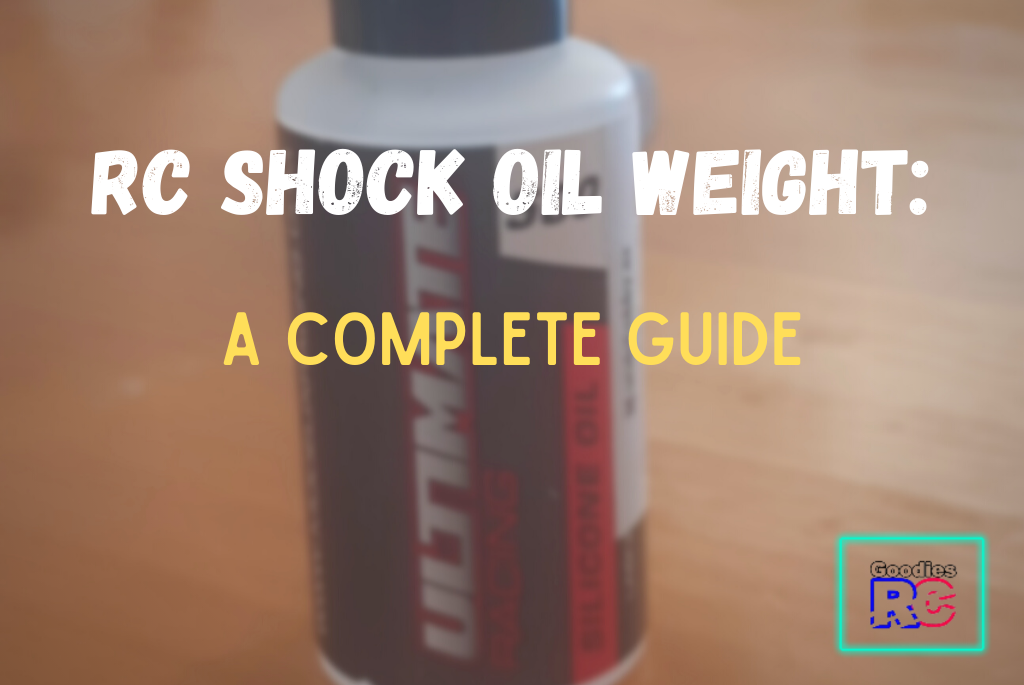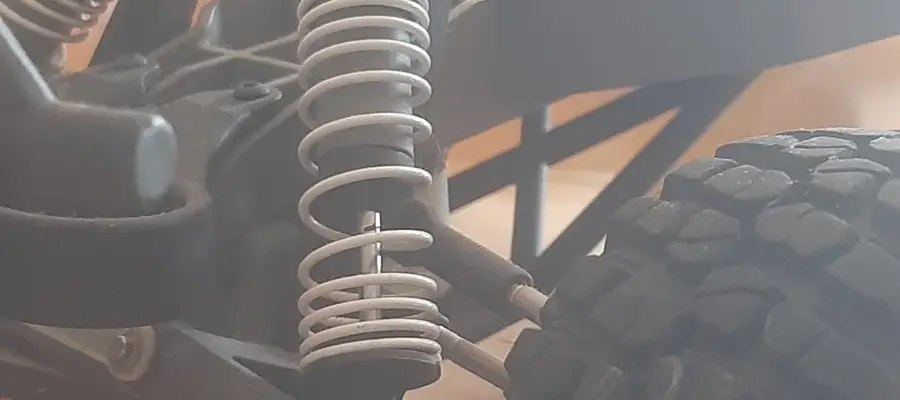RC shock oil is a specialized lubricant used in the shock absorbers of remote-controlled (RC) vehicles. The shock absorbers are responsible for controlling the suspension system and absorbing impact from jumps and bumps in the terrain.
The shock oil is important because it plays a critical role in determining the performance of the suspension system. The thickness or viscosity of the oil affects the damping characteristics of the shocks, which in turn affects how the vehicle handles and responds to the terrain.

It’s important to regularly check and replace the shock oil to ensure that the vehicle is performing at its best.
Choosing the right weight of shock oil depends on, among other things, the driving surface, driving style, and indoor or outdoor tracks. Here’s a table highlighting different shock oil weights and their ideal use cases:
| Shock Oil Weight | Good for |
| 10wt to 20wt | Carpet racing or smooth, high-grip surfaces. These oils provide faster shock rebound and compression, which is ideal for on-road cars. |
| 25wt to 35wt | Medium grip surfaces, such as indoor clay tracks. These oils provide a good balance between handling and stability. |
| 40wt to 50wt | Outdoor tracks with a rough surface or high jumps. These oils provide more damping, which can help absorb larger impacts. |
| 55wt to 70wt | Large jumps and extreme terrain. These oils provide the most damping, which is ideal for heavy cars or cars with stiff suspension setups. |
These are general guidelines, you will need to experiment with different shock oil weights to find what works best for your particular car and driving style if you don’t have the manufacturer’s recommendation.
If you are unaware of technical parts associated with the RC suspension system, I highly recommend checking out my complete guide about RC suspension types and parts.
The best oil for your RC shocks also depends on the weight and suspension setup of your car, and the type of car, here are some examples:
| Type of RC Car | Recommended Front Shock Weight | Recommended Front Shock CST | Recommended Rear Shock Weight | Recommended Rear Shock CST |
| 1/10 Touring Car | 50-60 wt | 350-400 cst | 40-50 wt | 300-350 cst |
| 1/8 Buggy | 60-80 wt | 400-450 cst | 50-70 wt | 350-400 cst |
| 1/8 Truggy | 80-100 wt | 450-500 cst | 70-90 wt | 400-450 cst |
| 1/8 Monster Truck | 90-110 wt | 500-550 cst | 80-100 wt | 450-500 cst |
| 1/8 On-Road Car | 60-80 wt | 400-450 cst | 50-70 wt | 350-400 cst |
| 1/10 Off-Road Buggy | 35-45 wt | 250-300 cst | 30-40 wt | 200-250 cst |
| 1/10 Off-Road Truck | 45-55 wt | 300-350 cst | 35-45 wt | 250-300 |
| 55-70 wt |
I suggest choosing the shock oil carefully and maintaining it properly as it’s crucial for optimal performance. Using the wrong shock oil will lead to inconsistent performance and reduce the lifespan of the shocks.
The shock oil weight refers to the thickness or viscosity of the oil and plays a critical role in determining the damping characteristics of the suspension system. Using thicker shock oil can cause the suspension to become stiff, leading to poor handling, and reduced traction. Using thinner shock oils, on the other hand, can cause the suspension to become too soft which will result in excessive body roll and reduced stability.
I recommend using thicker shock oil for smoother surfaces or high-speed tracks because it reduces body roll and provides better stability. If you’re driving on a smooth track, using thicker shock oil helps keep the car level during high-speed turns and reduces body roll when landing from jumps.
Thinner shock oil is more suitable for rough terrain and lower-speed tracks because it allows the suspension to move more freely and absorb impacts better. If you’re driving on a bumpy track, using thinner shock oil can help the suspension absorb the impacts more effectively and keep the wheels in contact with the ground for better traction.
To get the most out of your RC car’s performance, I suggest choosing the appropriate shock oil weight for your specific needs and adjusting it accordingly based on the track and driving conditions. By having a well-tuned suspension system, you can achieve optimal performance and handling. For example, if you notice your car bouncing too much on a bumpy track, you can adjust the shock oil weight to a thinner viscosity to help the suspension absorb the impacts more effectively.
For more on suspension, check out my RC car suspension parts and types guide
Choosing The Right Oil For Your Style
The track
The type of shock oil you use depends on the type of tracks and surfaces you will be driving on, your driving style, and the current conditions of the track.
Different tracks and surfaces have different levels of grip, bumps, and other obstacles that can affect the performance of your RC car. Smooth tracks with high traction levels require thicker shock oil to reduce body roll and provide more stability, while bumpy tracks require thinner shock oil to allow the suspension to move freely and absorb impacts better.
Track conditions
You should also consider the current conditions of the track when selecting the shock oil weight. Changes in temperature, humidity, and other weather conditions will affect the performance of your RC car.
Weather conditions
In hot weather conditions, thicker shock oil compensates for the reduced viscosity caused by high temperatures. In cold weather conditions, you’ll need thinner shock oil to ensure that the suspension moves freely and maintains proper performance.
Driving style
Your driving style is also a crucial factor to consider when selecting the shock oil weight. If you prefer driving aggressively, thicker shock oil will provide more stability and prevent body roll during high-speed turns. If your driving style is more relaxed, you’ll need a thinner shock oil to allow the suspension to move freely and provide a smoother ride.
RC Shock Oil Replacement

First, inspect the shock absorbers before changing the oil to identify any visible signs of damage, leaks, or wear. If you observe any damage or wear, replace the shock absorbers before changing the shock oil.
To change the shock oil, you need to remove the shock absorbers from the RC car. Specific instructions may vary depending on your car model, so consult the user manual.
To drain the old shock oil, hold the shock absorber upside down and let the oil drain into a container.
After draining the old oil, clean the shock absorbers with a cloth or paper towel to remove any debris or contaminants.
Using a syringe, refill the shock absorbers with the correct weight and type of new shock oil recommended for your car.
Reassemble the shock absorbers and reinstall them onto your RC car.
Test the suspension system and adjust the shock absorbers as necessary to ensure optimal performance and handling after changing the shock oil.
For a more detailed guide, please check out my article: Here’s How To Change The Shock Oil On Your RC Car
Conclusion
Proper selection and maintenance of shock oil are essential for optimizing the performance of your RC car’s suspension system. Carefully consider the type of track or surface you will be driving on, your driving style, and the current track conditions when selecting the shock oil weight. Thicker shock oil provides more stability and less body roll, while thinner shock oil allows for better absorption of impacts and increased traction.
It’s also crucial to maintain your shock absorbers by inspecting them for damage and wear. Regularly change the shock oil and clean the shock absorbers to help ensure that they continue to function correctly and provide optimal performance.
Consult the user manual for specific instructions on changing the oil and removing and reinstalling the shock absorbers. You can significantly improve the performance and handling of your RC car and increase your enjoyment of the hobby by doing this every few months.
I hope you found my article helpful, please check out my post: RC Shock Oils: The Only GUIDE You Need. It covers everything you need to know about RC shock oils. My guide to homemade RC shock oils may also be of interest

